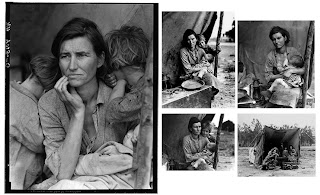Dorothea Lange (1895-1965)
I'm drawn to photographers who enter in and out of people’s lives for brief moments and capture their experience on film. Nan Golden, Diane Arbus, Mary Ellen Mark, Annie Leibovitz and of course the iconic Dorothea Lange are some of the photographers I enjoy.
I've often wondered how these photographers balance the emotional and personal connections they make with their subjects through the lens, especially if they are "just visiting". There is a fine line between being the outsider looking in, stealing a glimpse of someone's soul for personal gain. With this there is also the potential risk of being called an "exploitative photographer". With that said, I am more from the belief that photographers are ethnographers with a third eye.
I've often wondered how these photographers balance the emotional and personal connections they make with their subjects through the lens, especially if they are "just visiting". There is a fine line between being the outsider looking in, stealing a glimpse of someone's soul for personal gain. With this there is also the potential risk of being called an "exploitative photographer". With that said, I am more from the belief that photographers are ethnographers with a third eye.
Linda Gordon writes in her book Dorothea Lange: A Life Beyond Limits of Lange describing Dorothea Lange "...as a photographer of democracy, and for democracy."(W. W. Norton & Co., 2009)
The image she is most known for is "Migrant Mother" (1936) Nipomo, California
 |
| "Migrant Mother" (1936) Nipomo, California |
Lange recalls her experience taking the photograph of the 32 year old widow Florence Owens Thompson;
"She had just sold the tires from her car to buy food. There she sat, in that lean too tent with her children around and seemed to know my picture might help her so she helped me...there was a sort of equality about it."
Within days of Lange's visit published photographs triggered immediate food aid and called national attention to conditions to California's agricultural valleys.
Katherine McIntosh was 4 years old when the photo was snapped. McIntosh is the girl to the left of her mother when you look at the photograph. McIntosh speaking about her mother (Thompson); "She was the backbone of our family," McIntosh says of her mom. "We never had a lot, but she always made sure we had something. She didn't eat sometimes, but she made sure us children ate. That's one thing she did do."
So what can we learn from the democratic photographer and her subject? I find myself referring back to John Berger's "Ways of Seeing". For me, photographs influence what we say and how we go about trying to say what we mean. Photography is used as a communication tool that consciously and uninhibitedly removes the blinders while cropping out the world in our peripheral vision. All in all, photographs provide more questions rather than concrete answers. This makes me a better critical thinker and entrepreneur of social justice.
So what can we learn from the democratic photographer and her subject? I find myself referring back to John Berger's "Ways of Seeing". For me, photographs influence what we say and how we go about trying to say what we mean. Photography is used as a communication tool that consciously and uninhibitedly removes the blinders while cropping out the world in our peripheral vision. All in all, photographs provide more questions rather than concrete answers. This makes me a better critical thinker and entrepreneur of social justice.